In the sacred tradition of Orthodox Christianity, icons are not merely religious artworks — they are windows into the divine, tangible links between the earthly and the heavenly. To honor these holy icons, the faithful developed the practice of adorning icons with intricately crafted precious metal covers, known in Greek as Pamfyla and in Russian as oklad.
These covers, often made of silver, gold, or other precious metals, serve both as a spiritual purpose. The primary purpose of affixing metal coverings to icons lies in the profound reverence for the sanctity they embody — a practice which, over the centuries, evolved into a deeply rooted tradition within Orthodox Christian art and devotion. Through this tradition, they believe they are exalting the icon’s holiness through beauty and reverence. Carefully moulded to fit the contours of the figures, the riza leaves only the faces and hands visible, emphasizing the spiritual presence within the image while cloaking the rest in luminous splendour.
To cover an icon in metal is not to hide it — it is to crown it, proclaim its sanctity, and surround it with the dignity befitting a sacred presence. Each metal cover tells a story of devotion, offering, and the unbroken tradition of veneration that spans centuries.
The long-term material and structural impacts of metal revetments on Orthodox Christian icons, with an emphasis on conservation and restoration science, historical practice, and preventive care. Though deeply rooted in devotional customs and aesthetic enhancement, these metal additions often contribute to the physical deterioration of holy icons. Utilizing a multidisciplinary approach that includes chemistry, conservation and restoration ethics, and iconographic scholarship, the paper identifies key mechanisms of damage and offers modern strategies for sustainable heritage preservation.
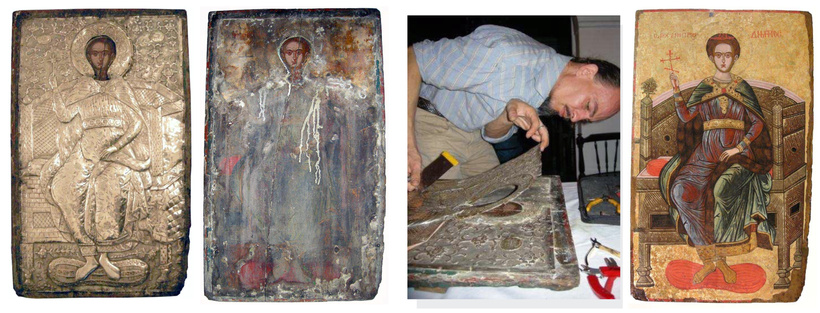
©VENIS STUDIOS
Devotion and Its Consequences
Orthodox icons transcend their function as mere religious artifacts; they embody theological discourse, serve as instruments of devotion, and constitute invaluable historical documents. In the course of their veneration, devout patrons frequently commissioned the application of silver or gilt metal coverings—commonly referred to as pamfyla or revetments. While these accretions were intended as expressions of piety and reverence, their direct application onto the painted surface of icons introduces a range of material and conservation challenges that often remain unacknowledged outside professional conservation contexts.
The evolving understanding of icons as complex, composite cultural heritage objects—rather than as static devotional images—has prompted conservators and restorers to critically reassess the long-term implications associated with such metal coverings. Interactions between silver revetments and painted icon surfaces are informed not only by historical precedent but also by contemporary conservation science, highlighting both the risks and necessary precautions integral to preserving these sacred artifacts.
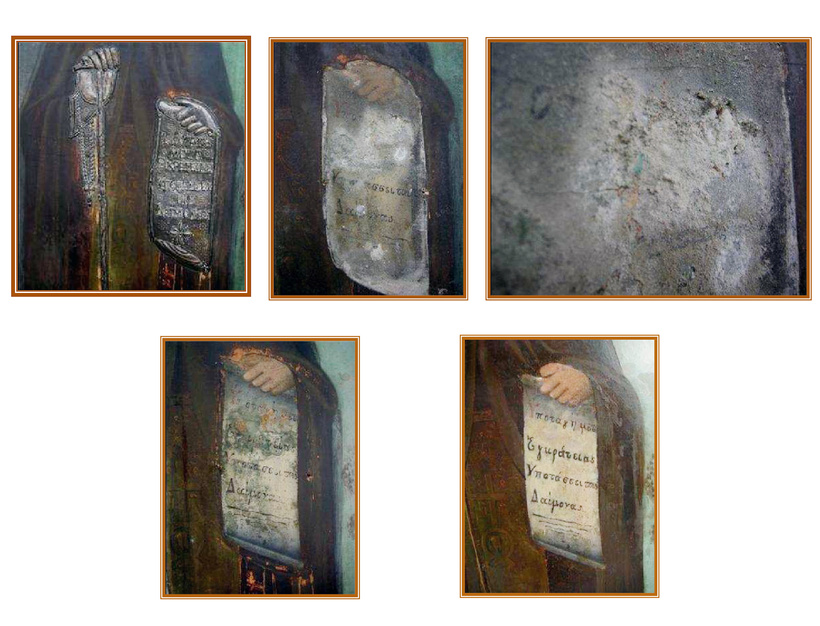
©VENIS STUDIOS
Material Incompatibility
Although the application of metal revetments—commonly silver, gold, bronze, or mixed alloys—was traditionally intended to honour and protect sacred imagery, modern conservation and restoration science reveals a range of material incompatibilities between metal coverings and painted icons. Many of these metals, while valued for their visual and symbolic prestige, exhibit reactive behaviors under ambient environmental conditions.
For example, silver, despite its classification as a noble metal, readily forms silver sulfide (Ag₂S) in the presence of airborne sulfur compounds, resulting in black tarnish. In enclosed or humid conditions, silver chloride (AgCl) may also develop due to chlorides present in the environment. Bronze and other copper-based alloys undergo similar corrosion processes, forming acidic oxides, sulfates, and chlorides that are chemically aggressive.
These corrosion products, when formed in close contact with the icon’s delicate paint layers, can catalyze hydrolytic degradation, discolouration, and the loss of adhesion in organic binders such as egg tempera. Moreover, metal ion migration into the ground and paint layer —especially in the presence of moisture— can cause irreversible staining, weaken stratigraphic cohesion, and compromise both the aesthetic and structural integrity of the icon.
Such interactions are of particular concern when metal coverings are affixed directly to the icon’s surface, as was often the historical practice. The absence of a microclimate buffer accelerates degradation, especially in icons exposed to fluctuating humidity, pollutants, or candle soot in devotional settings. As such, conservation professionals now recognize metal revetments as potentially damaging elements, and advocate for their non-invasive display or separation during conservation treatments, to preserve the original polychromy and structural stability of the icon.
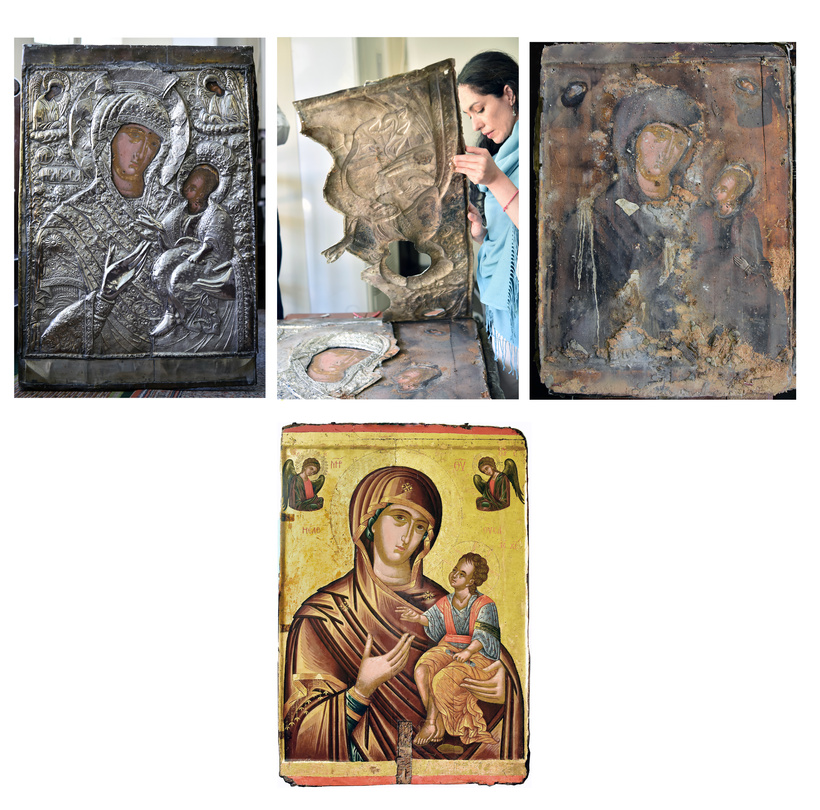
©VENIS STUDIOS
Microclimate Formation and Moisture Trapping
The intimate contact between metal revetments and the painted surface of icons frequently creates micro-environmental zones characterized by severely limited air circulation. These confined spaces facilitate the entrapment of moisture, particularly in settings subject to fluctuating relative humidity. Such conditions promote elevated humidity levels beneath the metal covering, leading to the formation of condensate on both the wooden support and the paint layers. Consequently, this microclimate fosters the proliferation of biological agents, including mould, fungi, and bacteria. Over extended periods, these factors critically undermine the dimensional stability of the wooden substrate, precipitating warping, increased susceptibility to insect infestation, and microbial colonization of both organic and inorganic components of the icon’s stratigraphy.
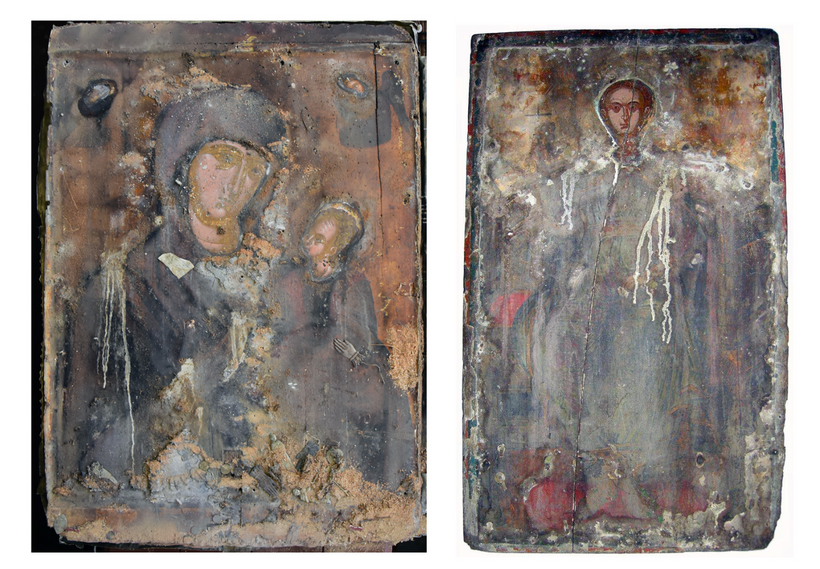
©VENIS STUDIOS
Mechanical and Chemical Damage
Historically, metal covers were affixed to icons through the use of small metal nails or folded edges. Such methods introduce localized mechanical stress concentrations, which can precipitate splitting or fracturing of the wooden support, structural destabilization, and consequential losses to the painted surface. These attachment techniques may also induce detachment or compression of paint layers, as well as surface abrasions caused by the micro-movements of metal elements resulting from thermal and hygroscopic expansion and contraction. Additionally, the application of adhesives or subsequent mechanical fastenings can provoke chemical incompatibilities or introduce modern synthetic compounds, thereby complicating or compromising conservation efforts.
Furthermore, cleaning interventions conducted by non-specialists often involve the use of chemical solvents and polishing agents. While these materials may effectively remove corrosion and restore the metallic luster, they frequently result in inadvertent cleaning and mechanical abrasion of the underlying painted layers. Consequently, the iconographic areas visible through the metal revetments are subjected to accelerated degradation, which may culminate in partial or complete destruction of the original painted surface.
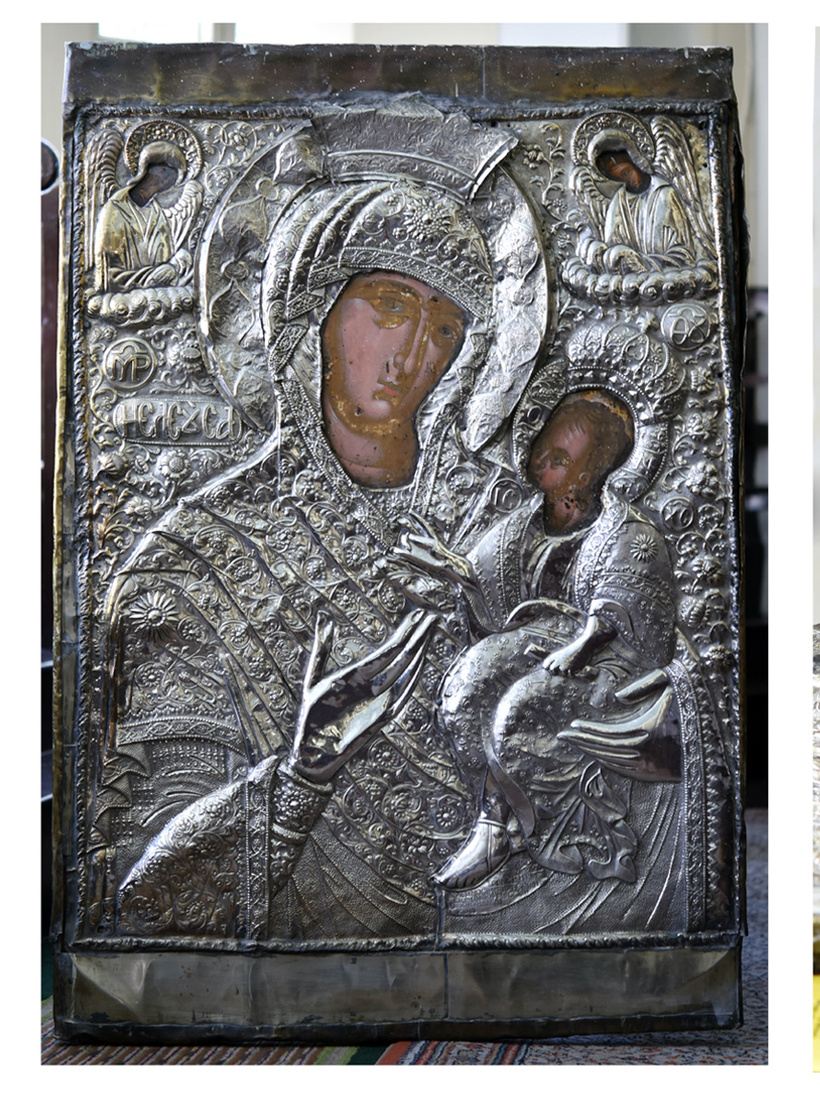
©VENIS STUDIOS
Iconographic and Scholarly Obscuration
From both academic and iconographic perspectives, metal revetments pose significant obstacles to the scholarly study of icons. They obscure critical features such as inscriptions, stylistic markers, the artist’s brushwork and hand, as well as essential dating evidence or underdrawings revealed through techniques like infrared reflectography. These obstructions hinder not only the accurate stylistic attribution of icons but also the effective monitoring of their conservation and restoration state. Consequently, deterioration phenomena such as pigment loss, varnish degradation, or cracking often remain undetected until the metal covers are removed, frequently unveiling damage that is irreversible.
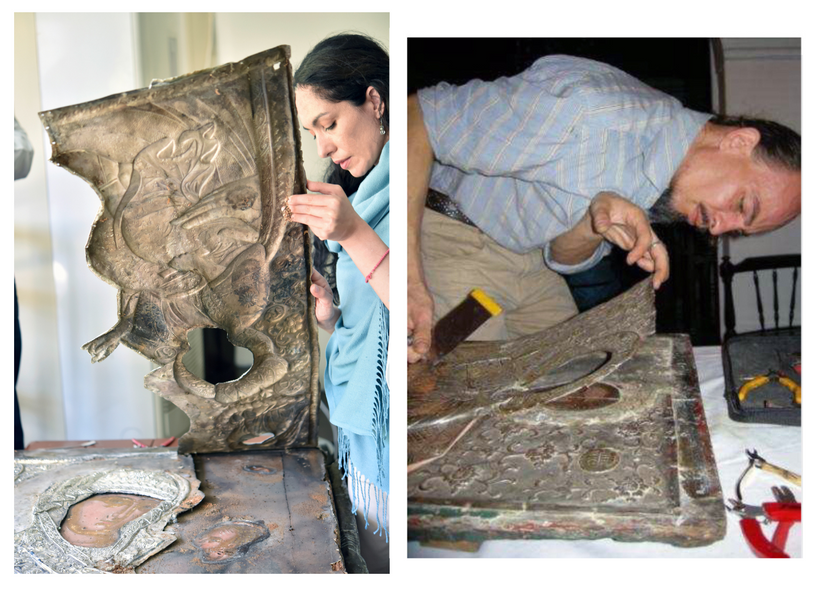
©VENIS STUDIOS
Conservation and Restoration Ethics
In light of the material, structural, and iconographic risks posed by prolonged contact between metal revetments and painting icon surfaces, conservation and restoration ethics increasingly advocate for the permanent separation of these composite elements. Detaching the revetment and mounting it onto a newly constructed, dimensionally identical wooden support enables both the icon and its metal covering to be preserved under optimal, individualized conditions, free from mutual degradation. This methodological approach not only safeguards the icon painting surface from chemical and mechanical damage but also allows for the full scholarly and devotional appreciation of the icon’s iconography, inscriptions, and historical layers. Simultaneously, the revetment—understood as a sacred vestment and artifact of devotional history—is treated as an independent object of liturgical, aesthetic, and cultural significance. When displayed on a surrogate support, with precise alignment of its apertures over high-resolution photographic reproductions of the original icon, the revetment retains its symbolic and theological function. In this dual-preservation strategy, the sacred unity of image and adornment is intellectually and visually maintained, while the material integrity of each is protected—resulting, in essence, in the creation of two coexisting embodiments of the same icon: one original, conserved and visible in its entirety; the other, a faithful liturgical echo of its historical veneration.
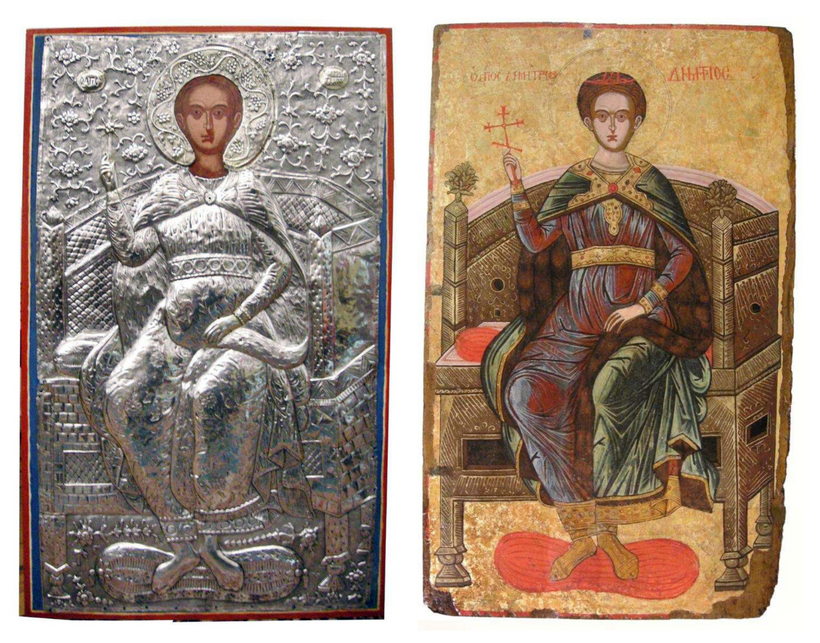
©VENIS STUDIOS
Sacred Vestments and the Stewardship of Holiness
In the enduring dialogue between earthly craft and divine presence, Orthodox icons stand as sacred thresholds—windows through which the faithful glimpse the eternal. The tradition of enveloping these holy images in precious metal coverings emerges not merely as an artistic embellishment but as an act of reverence, a luminous vestment that crowns the icon’s spiritual essence. These metal revetments, while radiant symbols of veneration, also silently bear the weight of time’s material consequences—revealing the fragile balance between devotion and preservation.
As custodians of this sacred heritage, conservators and restorers serve as art doctors—delicately diagnosing, treating, and healing the wounds inflicted by time and circumstance. They navigate the tension between honouring centuries-old devotional practices and safeguarding the icon’s tangible legacy for future generations. The interplay of chemistry, art, and ethics invites us to reconsider how beauty and sanctity coexist with material vulnerability. In this light, conservation and restoration is not only a scientific endeavour but a solemn act of humility—acknowledging that beneath the gilded surface lies the delicate heart of faith, fragile yet radiant, demanding care that respects both its spiritual and physical dimensions.
Thus, the metal cover is not simply a shield but a testament: to human devotion, the transcendent beauty of holiness made visible, and the enduring responsibility of preservation. In protecting the icon, we honour the sacred dialogue between past and present, earthly hands and heavenly grace—a dialogue that continues to inspire awe, reflection, and reverent stewardship.
I want to learn more:
by Venizelos G. Gavrilakis
Edited Athina Gkouma
About the author:
Venizelos G. Gavrilakis, a renowned Senior expert art and antiquities conservator and restorer one of the few internationally experts of Byzantine and post-Byzantine icons, his expertismes expand also in historical oil paintings, and Ottoman-era artwork, historical artworks and antiquities. He has been working as a senior expert conservator and restorer since 1994 for more than 30 years. He has worked with various institutions and has been involved in international conservation meetings and conferences. He has also made 3 art restoration and conservation documentaries which they have been played on TV and cinemas. Gavrilakis is the president of the art and antiquities conservation and restoration company VENIS STUDIOS, based in Istanbul, Turkey, and has collaborated with goverment departments, museums, galleries, antique dealers, and private collectors.

